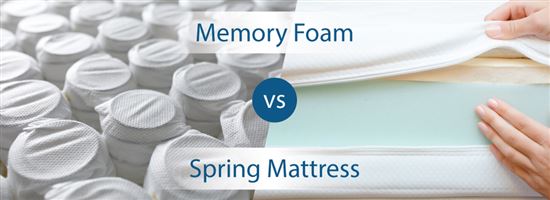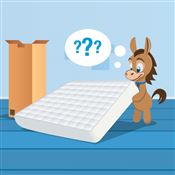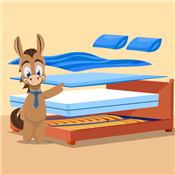Foam vs Spring Mattress
What's the difference between memory foam and innerspring? Find out the pros and cons of each, and see which is best for you.
 |
On the surface, mattresses all look the same—it's just a big, boxy thing you sleep on, right?
But dig deeper, and you'll find that not all mattress materials are right for you.
Some materials are great for cushioning your pressure points. Others are best for keeping you cool.
Most mattresses fall into 2 categories: foam or spring. Check out this comparison for a complete guide on choosing the best one for your sleep style.
What Is a Foam Mattress?
Foam mattresses have spiked in popularity in recent years. But did you know there are multiple types of foam? Memory foam, polyurethane foam, and latex foam are the main types. Here's how they're different:
Memory Foam
Have you ever lain on a foam mattress and felt like it hugged your whole body? That was probably a memory foam mattress. This cushy material is known for molding to the contours of your body.
Memory foam was actually developed by NASA in 1966 to make safer aircraft cushions. It shapes to your body and bounces back slowly. So if you press your hand into it, you'll see it hold onto the imprint for a bit.
Polyurethane Foam (Polyfoam)
Polyfoam is the most common foam type, and it's also one of the most affordable. You can often find a layer of it closer to the top of your mattress. It bounces back faster than memory foam. You won't feel completely stuck in the mattress like you might with memory foam.
There's a wide range of densities available. The lower the density, the lower the cost and durability.
Latex Foam
Latex foam is made from the sap of rubber trees. It's much springier than the other foams, and it can also be much firmer. Latex is the most durable mattress material you can get. Most mattresses last 8-10 years. But latex mattresses can last up to 20 years.
There are two types of latex: Dunlop and Talalay. Dunlop is denser and more durable. Talalay is softer and more uniform. With both types, you can find mattresses that are 100% natural and organic.
Foam Pros and Cons
Foam is great if you want pressure relief. But what if that's not your main concern? Check out what's good about foam and what to look out for:
Pros
- Cushions the body and hugs curves
- Great pressure relief
- Lots of affordable options
- Doesn't transfer motion (good for couples)
- Material doesn't make noise
Cons
- Sleeps hot
- Might not support heavy people
- Can be hard to move around on
- Some new mattresses off-gas
- Most options are on the softer side
There are pros and cons to every mattress. But modern foam mattresses do their best to address the cons. The Nectar mattress, for example, uses foam that stays cool at night. It's a great option if you want good pressure relief without getting sucked into the bed.
All mattresses wear down eventually, but foam mattresses tend to last longer. Springs are made of wire, which compresses and warps over time. You can extend the life of both types by rotating it every 3-4 months and not jumping on it.
What Is a Spring Mattress?
Ever jump on your grandma's bed as a kid? Then you know what an innerspring mattress feels like. Innersprings, or springs, are mattresses that have a coil support system. That's what gives these mattresses their characteristic bounciness.
Spring mattresses are the oldest type of mattress. But modern innersprings have come a long way from the hard beds of the past. It all comes down to the different coil types:
Bonnell Coil
These are the oldest type of coil (invented in the 1800s!) and the noisiest. Bonnell coils start creaking when they wear down. They're also the least durable coil type.
Continuous Coil
This type of spring is made with a single piece of wire. The wire gets twisted into rows of coils. They're more stable and durable than Bonnell coils.
Offset Coil
Offset coils are hourglass-shaped springs that are linked together with wire. This gives you better body contouring compared to the last two coil types.
Pocketed Coils
Pocketed coils are the modern version of springs. They're made of coils that are individually wrapped in fabric. This gives you the best body contouring. Since the springs aren't interconnected, the mattress won't dip when you lie on it.
Spring Pros and Cons
Spring beds offer a lot of support. But not everyone needs all the extra firmness. Before you buy a new mattress, make sure you know the pros and cons of each type:
Pros
- Very bouncy and easy to move on
- Extra firmness and support
- Lots of airflow in the coils keep you cool
- Good range of affordable options
- Great edge support lets you use entire surface
Cons
- Bounciness can wake up a sleeping partner
- Doesn't conform to the body
- Can be noisy
- Few soft options
- Short lifespan
The best innerspring mattresses are ones with pocketed coils and comfy top layers. The Saatva Classic is a great example of this. Unlike old-fashioned spring mattresses, modern ones like this aren't excessively squeaky or hard.
What's the Difference?
So, how do foam and spring mattresses stack up? Here's a head-to-head comparison of both mattress types.
Cost
Both innerspring and foam mattresses are pretty affordable. As with any product, there are expensive options. But if you're on a budget, you'll have no problem finding cheaper beds of each type.
Quality/Durability
You can find high-quality mattresses of any material. But if we're comparing mattresses in the same price range, foam beds will usually last longer. Coils usually wear down faster and start sagging where you sleep.
Comfort
Foam is the winner when it comes to comfort. The material takes pressure away from your body. It's an especially great option if you wake up with aches and pains.
Support
You can't beat an innerspring when it comes to support. The steel coils keep your body aligned throughout the night. It's great for heavy folks who need a strong mattress that doesn't sag.
The best mattress for your back is one that keeps your spine in alignment. This means your body is resting in a natural, neutral position—no awkward bending or arching of the back or hips.
Mattress Temperature
Spring mattresses are the coolest sleeping surface. Plenty of air gets through the coils. This prevents your body heat from building up and making you hot. Memory foam is notorious for sleeping hot. But you can get specialty foams (like gel foam) that's designed to be cooler.
Edge Support
If you want to use the full surface of your bed, edge support is key. Spring mattresses have better reinforcement around the perimeter than foam. This means you can sit and sleep on the edge without fear of falling off.
Motion Isolation
Motion can be an issue if you sleep with a partner. Foam mattresses will prevent movement from spreading through the bed. So, if you're a light sleeper, you won't feel your partner's tossing and turning. Springs are bouncy, so you're more likely to get jolted awake.
Smell/Off-gassing
Some foam mattresses have a new mattress smell called off-gassing. The odor can linger up to a few days. The off-gassing process is harmless, but it's something to consider if you're sensitive to smells.
Spring mattresses can off-gas to a lesser degree if they contain foam layers.
Which Mattress Is Best for Me?
There isn't a single best mattress type. It all depends on what kind of sleeper you are and what you need. What's your sleeping style?
Side Sleeper
When you sleep on your side, you put a lot of pressure on your hips and shoulders. Look for a bed on the plush side to avoid crushing your shoulders. A foam mattress offers the right amount of cushion to cradle your body.
Back Sleeper
If you're a back sleeper, you need a good balance of cushion and support. Luckily, you can find that with both spring and foam beds. Just be sure your bed hugs your lower back. This will make sure your spine is aligned with your body.
Stomach Sleeper
You don't want your hips to sink into the mattress when you sleep on your stomach. A firm mattress is best for you. In general, spring mattresses are your best bet for a firm, supportive sleep surface.
Combination Sleeper
If you tend to change positions throughout the night, you need a versatile mattress. A medium-firm bed of either type should work. Or, you can pay attention to which position you sleep in most. You can't go wrong picking a mattress type that works well with your main position.
If you have specific sleep issues you want to tackle, take a look where you fall on this table:
| What's my sleep concern? | Best mattress type |
|---|---|
| Sleeping hot | Spring |
| Aches and pains | Foam |
| Couples who are light sleepers | Foam |
| Good for sex | Spring |
In the end, your personal preference matters most. Don't choose a mattress type you hate the feel of. So if you're a hot sleeper who loves the feel of foam, don't get discouraged. Chances are, you'll be able to find a mattress with special features that address your concerns.
How to Get the Best Deal on a Mattress
Great deals are all around, no matter which type of mattress you go with. Here are the best ways to make sure you're not getting ripped off for your next mattress.
Know When to Shop
The best times to buy a mattress are:
- Late winter/early spring: Retailers offer discounts between February and May to make room for new models.
- Holiday weekends: Look for sales during Presidents Day, Memorial Day, 4th of July, Labor Day, Veterans Day, and Black Friday.
- Online, anytime: Shop online to get the best deals and save 50%-60% off in-store prices
Negotiate the Price
If you're shopping at a mattress store, make sure you haggle the price. Stores often mark up their prices because they know customers will try to bargain. Even if you can't get a lower price, the salesperson might throw in some free pillows to sweeten the deal.
Comparison Shop
You'll never know if you're getting the best price if you limit your search to just one store. Make sure you take a look at multiple stores and websites. If you can't find the exact mattress at multiple retailers, look for similar features to compare.
Bottom Line
Foam and spring mattresses differ in a lot of ways. But neither is the definitive best mattress type. What matters most is how the mattress works with your body and preferences.
If you're a side sleeper, need lots of cushion, and are a light sleeper, a foam mattress could be right for you.
If you're a stomach sleeper, need strong edge support, and sleep hot, check out a spring mattress instead.
Mattresses aren't a one-size-fits-all purchase, so take your time comparing features to find the right one. Remember, sleep is important in all aspects of life. And a good mattress is a valuable investment in your health.
Donna Tang is a content associate at CreditDonkey, a mattress comparison and reviews website. Write to Donna Tang at donna.tang@creditdonkey.com. Follow us on Twitter and Facebook for our latest posts.
Note: This website is made possible through financial relationships with some of the products and services mentioned on this site. We may receive compensation if you shop through links in our content. You do not have to use our links, but you help support CreditDonkey if you do.
Not sure what mattress is right for you?
Answer a few short questions in our mattress quiz to receive tailored recommendations.
Read Next:







